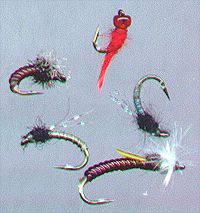|
|
Chironomid imitations can be tied in very simple or meticulously detailed versions with both proving to be very effective. Key ingredients include a characteristically slim abdomen separated from a larger thorax.
Like imitations of many different insects... matching the general profile and approximate size may be the determining factors to their effectiveness from one day to the next, or one water to another. The following example is a fairly simple and basic design; but creating a variety of "species" for this pattern is as easy as varying the materials and/or colors used, as well as tying in hook sizes from #12 thru #20. We cannot emphasis the importance of having a wide variety of sizes, colors, and profiles in your nymph boxes and suggest you read our accompanying articles CHIRONOMIDS - Alaska's Rice Bowl and Alaska's Best Kept Secret - Fly Fishing the Stillwaters for further reference.
|

|
1. Thorax - Fine dubbing material of choice. (peacock herl can be substituted to form a thorax creating the iridescent shine of many natural insects)
2. Ribbing - Wire or fine tinsel in copper, silver, red or black. (reflective materials that contrast with the abdominal thread enhance the segmented effect)
3. Thread - Uni-Thread in 6/0 - 8/0 diameters
4. Hook - Pupa or scud hooks e.g. Tiemco 2457 in sizes #12 - #20
|
TYING:
- Tying thread will determine the abdominal color, which can include white, cream, olive, brown, black, and red with other variations.
- Wrap the hook shank from the eye to the bend in the desired thread color.
- Tie in a small diameter wire or contrasting ribbing material near the tail. Completely and smoothly cover the shank with thread because this layer will serve to form the abdominal section. Return the thread to the margin between the abdomen and the thorax.
- Wrap the ribbing material forward over the thread abdomen to create a segmented appearance. Tie down ribbing at the abdominal/thoracic junction leaving the thread at this point.
- Sparsely dub the tying thread with chosen dubbing material, then wrap forward to form the thorax. Whip finish at the eye.
Field Notes: Inspite of their diminutive size, midge larvae, emergers and adults comprise a significant importance in the early stages of all Alaska freshwater species and are a major protein source for many landlocked adult trout, char, and grayling who reside in lakes which have no connection to salmon run streams and alternate food sources.
This pattern is very effective in Alaska lakes when fish appear to be feeding on the surface yet no hatch is observed. Most likely the fish are feeding on chironomid emergers in the surface film which are too tiny to observe. Late evening hatches occur nearly every day and the adaptable angler will concentrate his/her efforts in the 8pm - 11pm timeframe. Afternoon winds usually die out leaving lakes glassy calm and making sight-fishing/casting quite easy. But beware, lake residents, whether trout or grayling will be gorged by 10 or 11pm and go off the bite. Most anglers will have had enough catching by that time anyway.
Patterns tied by Brad Hanson
Photo by B. Hanson ©2000


Alaska Flyfishing Online
|
All Content Copyright ©1996-2014
Visual Media Design, Alaska Outdoor Journal, Alaska Flyfishing Online
All Rights Reserved
|
|



